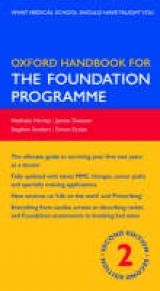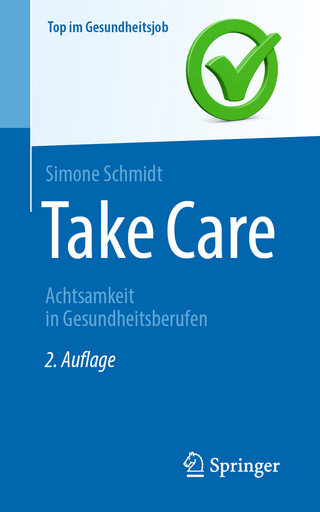
Oxford Handbook for the Foundation Programme
Oxford University Press (Verlag)
978-0-19-856789-9 (ISBN)
- Titel erscheint in neuer Auflage
- Artikel merken
The Oxford Handbook for the Foundation Programme is the first book to be written for doctors on the new UK Foundation Programme. It has been written by junior doctors with specific reference to the different style of training offered by the new changes in postgraduate education. It is the most useful book you can carry during the critical first two years after medical school. As you start your job it will guide you through your on-call emergencies, day-to-day ward life and specialty attachments whilst helping you adapt to your career, get the most out of your job and choose a specialty. It contains the simple factual guidance you'd expect from an Oxford Handbook. The clinical sections are arranged by symptom and have a clear, step-by-step format for the emergency management of your patients. This book gives you the best questions to ask for the history, tells you what to look for in examination, and guides you to the correct diagnosis and treatment. This presentation-based approach ensures you can offer the best treatment for your patients, whose diagnoses often aren't clear at first.A practical, ward-based approach is taken for common on-call problems - including sliding scales, warfarin dosing, and falls.
The specialty sections range from A & E to urology, highlighting the important differences in approach, with a succinct guide to the management of common specialist conditions. Also covered are practical procedures ranging from cannulation to chest drains, outlining indications, equipment and the actual procedure. Wherever possible, hints for success have been included. Interpretation of investigation results includes the ECG, CXR and blood tests, providing a quick reference scheme invaluable for years to come. The book ends with the common drug doses that all doctors should know, but sometimes need to double check. The Oxford Handbook for the Foundation Programme also contains a non-clinical section tackling issues from interview technique to tax assessment. It includes all relevant addresses and website references to help you find the information you need.
Stephan Sanders has wanted to be a doctor since the age of 12, shortly after becoming disillusioned with the astronaut pension scheme. He trained at Nottingham medical school where he wrote a 'Crash Course' textbook on the endocrine and reproductive systems during his paediatrics attachment. Surprisingly he still passed the paediatrics exam and decided this was clearly a good speciality. After medical school he worked in Queen's Medical Centre, Nottingham then Derbyshire Royal Infirmary, Derby. He eventually hopes to train as a clinical geneticist and will soon be starting a paediatrics rotation at Northwick Park, Harrow. Alongside genetics Stephan is also interested in high altitude and expedition medicine. He enjoys travelling, cycling, mountaineering and skiing in his spare time. In the future he hopes to unite the fields of quantum physics and ward based medicine to explain several medical phenomena including why you can never locate the notes and drug chart at the same time. James Dawson is still searching for his niche within the profession, being torn between anaesthetics and emergency medicine. After graduating from Sussex in Biochemistry with Neurobiology, James found that research was not his bag and embarked upon a medical degree in Leicester. It was during his undergraduate medical training that James became involved with publishing. After writing to a publisher to complain that a text was full of mistakes and not very user-friendly, James became an undergraduate medical representative, offering his naive opinion on books and manuscripts. During his final year he was asked to write his first book, on undergraduate pharmacology. Having been exposed to many teachers and numerous textbooks, both good and bad, James appreciates that learning can be difficult and frustrating, and tries to simplify education at any opportunity. Outside of work James enjoys digital photography, classic and modern film, Greek Mythology and most of all time with friends. Born and brought up in London, Shreelata obtained her medical degree from Imperial College, and has now chosen a career in obstetrics and gynaecology. It was on the rebound after an intercalated degree in Biochemistry that Shreelata had her first opportunity to try medical writing (a Crash Course on the Renal and Urinary system). As an undergraduate student, she recognised the importance of good teaching and senior guidance - both of which she hopes will be represented by this Handbook. In her spare time, Shreelata has a keen interest in fashion, often designing and personalising accessories, and has a passion for travel. Her eventual plan is to retire by a beach, cocktail in hand, safe in the knowledge that the shops are but an hour away. Simon Eccles is a member of the MMC (Modernising Medical Careers) working party on the Foundation Programme, and the follow on Run-Through-Grade. He is also the Chair of the BMA Junior Doctors Committee and has been part of the consultation exercise on the Foundation Programme from the its beginning in 2002. "
THE JOB; 1. Before You Start; 2. How to be a PRHO; 3. Clinical Notes; 4. Prescribing; 5. Daily Duties; 6. Ward Round; 7. Difficult Patients; 8. Discharge/TTOs; 9. Driving Regulations; 10. Referrals; 11. Being On Call; 12. The Night Shift; 13. Surviving; 14. The Medical Team - us; 15. Multi-Disciplinary - Them; 16. Labs; 17. Occupational Health; YOUR CAREER; 18. Teaching/Presentations; 19. Continuing Your Education; 20. Research and Academia; 21. Statistics; 22. Keeping Track; 23. Exams and Royal Colleges; 24. Career Progression; 25. Choosing a Job; 26. List of Careers/Specialties; 27. Getting a Job; 28. Moving/Finding a House; 29. Starting Work in the UK; 30. Working Abroad; COMMUNICATION; 31. Communication and Conduct; 32. Patient Communication; 33. Patient Centred Care; 34. Violence and Aggression; 35. Language; 36. Outside Agencies; ETHICS; 37. Dealing with Death; 38. Death Process; 39. Religion; 40. Confidentiality and Capacity; 41. Consent; WHEN THINGS GO WRONG; 42. Medical Errors; 43. Incident Reporting; 44. Hating Your Job; 45. Negligence and Complaints; 46. Colleagues and Problems; BORING BUT IMPORTANT; 47. NHS Structure; 48. Clinical Governance; 49. Benefits; 50. Finance; 51. Other Money; CLINICAL PRESENTATIONS; 52. History and Exam; 53. Early Warning Scores; 54. Arrest; 55. Cardiovascular; 56. Respiratory; 57. Abdomen; 58. Neuro; 59. Endocrine/Metabolic; 60. Infectious; 61. Ward Cover; 62. Night Sedation; 63. Limbs; SPECIALTIES; 64. Surgery; 65. Paediatrics; 66. Obs and Gynae; 67. Psychiatry; 68. General Practice; 69. A&E; 70. ITU and Anaesthetics; 71. Orthopaedics; 72. Rheumatology; 73. ENT; 74. Urology; 75. Ophthalmology; 76. Dermatology; 77. Haematology; 78. Oncology; 79. Palliative Care; PROCEDURES; 80. Introduction; 81. Venepuncture; 82. Blood cultures; 83. Femoral stab; 84. IV cannulation; 85. Arterial blood gases; 86. Injections - SC and IM; 87. Giving IV drugs; 88. ECG; 89. Cardiac monitors; 90. Exercise testing; 91. Cardioversion; 92. Central lines; 93. Pleural taps; 94. Chest drains; 95. Catheterisation; 96. NG tubes; 97. Ascitic tap; 98. Lumbar puncture; 99. Joint aspiration; 100. Local anaesthetics; INTERPRETING RESULTS; Venous blood tests; 101. Full blood count (FBC); 102. Clotting; 103. Cardiac markers; 104. Inflammatory response; 105. Urea and electrolytes (U+E); 106. Liver function tests (LFT) and amylase; 107. Calcium and phosphate; Other fluids; 108. CSF; 109. Urine; 110. Arterial blood gases (ABG); X-rays; 111. Chest X-ray (CXR); 112. Abdomen X-ray (AXR); Others; 113. Respiratory function tests; 114. Electrocardiogram (ECG); APPENDICES; Useful numbers and websites; Height conversion; Weight conversion; Body mass index; Interesting cases; Blank telephone No 1; Blank timetable 1; Blank telephone No 2; Blank timetable 2; Blank telephone No 3; Blank timetable 3
| Erscheint lt. Verlag | 1.9.2005 |
|---|---|
| Co-Autor | James Dawson, Shreelata Datta, Simon Eccles |
| Zusatzinfo | numerous tables, line drawings, black and white illustrations |
| Verlagsort | Oxford |
| Sprache | englisch |
| Themenwelt | Medizin / Pharmazie ► Allgemeines / Lexika |
| ISBN-10 | 0-19-856789-8 / 0198567898 |
| ISBN-13 | 978-0-19-856789-9 / 9780198567899 |
| Zustand | Neuware |
| Haben Sie eine Frage zum Produkt? |
aus dem Bereich



